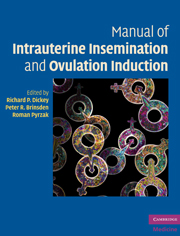Book contents
- Frontmatter
- Contents
- List of contributors
- Preface
- 1 An overview of intrauterine insemination and ovulation induction
- 2 Male causes of infertility: evaluation and treatment
- 3 Female causes of infertility: evaluation and treatment
- 4 Clinic and laboratory design, personnel and equipment
- 5 Semen analysis: semen requirements for intrauterine insemination
- 6 Semen preparation for intrauterine insemination
- 7 Ovulation induction for intrauterine insemination I: oral drugs clomiphene, tamoxifen, letrozole
- 8 Ovulation induction for intrauterine insemination II: gonadotropins and oral drug–gonadotropin combinations
- 9 Ultrasonography in the management of ovulation induction and intrauterine insemination
- 10 Insemination technique and insemination complications
- 11 Cryopreservation
- 12 Donor sperm
- 13 The role of the nurse in intrauterine insemination and ovulation induction
- 14 Complications of ovulation induction I: high-order multiple births, miscarriage, ectopic pregnancy, congenital anomalies, ovarian cancer
- 15 Complications of ovulation induction II: ovarian hyperstimulation syndrome, ovarian torsion
- 16 The psychological issues of intrauterine insemination
- 17 Ethical, legal and religious considerations of artificial insemination
- Index
10 - Insemination technique and insemination complications
Published online by Cambridge University Press: 01 February 2010
- Frontmatter
- Contents
- List of contributors
- Preface
- 1 An overview of intrauterine insemination and ovulation induction
- 2 Male causes of infertility: evaluation and treatment
- 3 Female causes of infertility: evaluation and treatment
- 4 Clinic and laboratory design, personnel and equipment
- 5 Semen analysis: semen requirements for intrauterine insemination
- 6 Semen preparation for intrauterine insemination
- 7 Ovulation induction for intrauterine insemination I: oral drugs clomiphene, tamoxifen, letrozole
- 8 Ovulation induction for intrauterine insemination II: gonadotropins and oral drug–gonadotropin combinations
- 9 Ultrasonography in the management of ovulation induction and intrauterine insemination
- 10 Insemination technique and insemination complications
- 11 Cryopreservation
- 12 Donor sperm
- 13 The role of the nurse in intrauterine insemination and ovulation induction
- 14 Complications of ovulation induction I: high-order multiple births, miscarriage, ectopic pregnancy, congenital anomalies, ovarian cancer
- 15 Complications of ovulation induction II: ovarian hyperstimulation syndrome, ovarian torsion
- 16 The psychological issues of intrauterine insemination
- 17 Ethical, legal and religious considerations of artificial insemination
- Index
Summary
Introduction
Insemination technique has changed greatly during the past 40 years, from a simple vaginal technique that was little different than that used by John Hunter in 1785 to intracervical (ICI), intrauterine (IUI), fallopian tube sperm perfusion (FSP) and direct intraperitoneal insemination (DIPI) techniques. When Nachtigall et al. reviewed the status of artificial insemination in 1979, nearly all inseminations were vaginal and pregnancy rates were generally satisfactory when donor sperm was used or insemination with partner sperm was performed because of physical problems, but very poor when insemination with partner sperm was performed because of low sperm count. The semen specimen was usually fresh for both donor and partner insemination, except in rare cases where multiple samples of poor-quality sperm were cryopreserved in the hope that sufficient “good” sperm would be available when the accumulated specimens were thawed. Those cases were nearly always unsuccessful.
Successful pregnancies following intrauterine insemination of 10 minims (0.6 mL) of fresh unprocessed sperm were reported in 1920, but the procedure was abandoned because of concern about infection. Furthermore, the amount inseminated had to be kept small to reduce uterine cramping, so it was not helpful in cases where the sperm count was low. When insemination techniques were compared in 1957, pregnancy rates for IUI were worse than when the entire sperm specimen was placed in a cervical cup applied to the cervix, or simply deposited in the vagina.
In the present day, insemination with both donor and partner semen is nearly always performed by the intrauterine insemination (IUI) technique.
- Type
- Chapter
- Information
- Manual of Intrauterine Insemination and Ovulation Induction , pp. 109 - 118Publisher: Cambridge University PressPrint publication year: 2009

